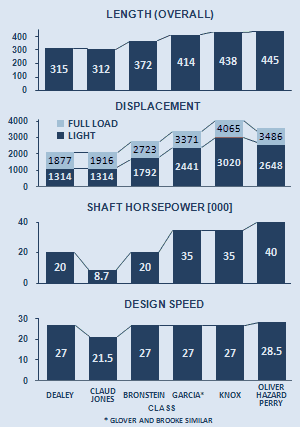
Comparison of the ASW escort classes.

Beginning in F/Y 1952, new classes intended for modern antisubmarine warfare (ASW) were authorized to take their place. The US Navy service life of the first generation “ocean escorts”—13 Dealeys and four Claud Joneses—was short: commissioned in 1954–60 as DEs, they were all sold or scrapped by the end of 1974.
A second generation of classes Bronstein (2 ships), Garcia (10) and Knox (46) classes arrived. Differentiated from earlier classes by their “hurricane bows” for improved seakeeping and a “mack” (a combined mast and stack), and from one another by their ever-increasing size, they commissioned as DEs beginning in 1963, were redesignated frigates (FF) in 1975 and remained in commission until after 1990. Adaptations of the Garcias were the experimental Glover and the six guided missile-equipped Brookes, which commissioned as DEGs 1–6 in 1967–8, were redesignated frigates (FFG 1–6) in 1975, and decommissioned in 1994.
In 1977, to replace the large numbers of World War II destroyers retiring from ASW service, the Navy began commissioning a third generation of ASW escort, the Oliver Hazard Perry class guided missile frigates. Again, the need for large numbers kept down size and cost, but the class has proved successful: of 55 ships (FFG 7–61) completed by US yards over a 12-year period (51 for the US Navy and four for Australia) and 16 more built abroad, 30 are still in commission in the US Navy as are many in foreign navies.